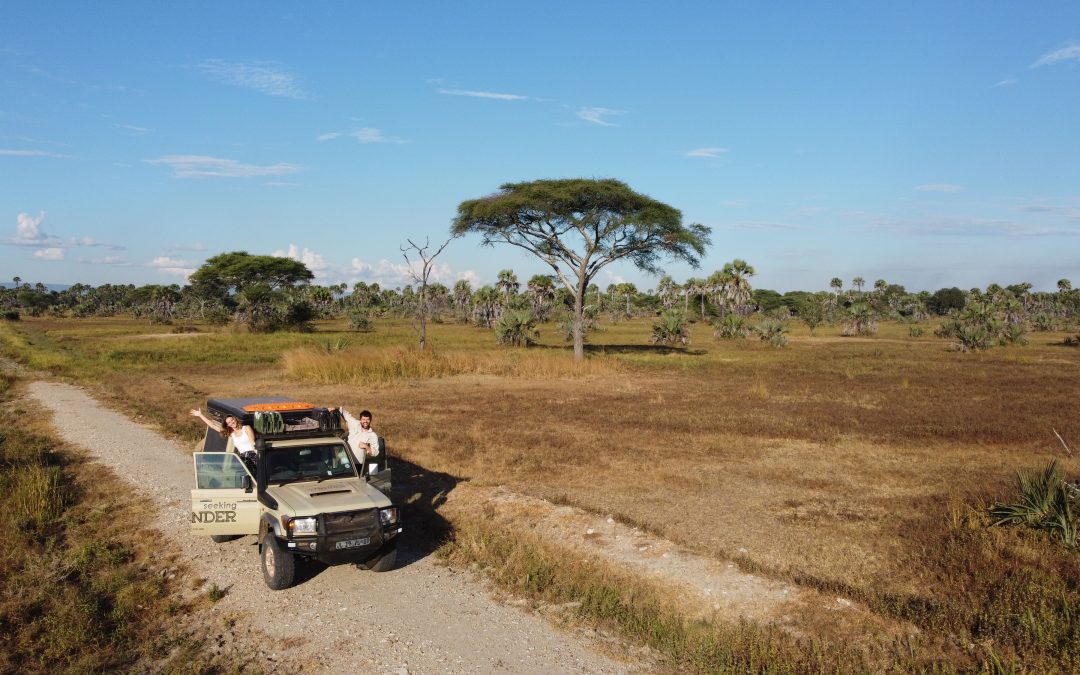‘I’m sure it’s fine if you get out here for a photo, we haven’t seen a sign of predators all day,’ I said confidently to Simoné. And just then, a lioness strolled out of the long grass – right on cue. But wait, there is more. About 15 more lions to be exact, some of which were up a tree, draped uncomfortably over branches like great sacks of feline awkwardness. Tree-climbing lions is a thing in East Africa, and many believe they do it attempting to escape the constant irritation of tsetse flies. Whatever the reason, it is fascinating to find these large tawny cats behaving like leopards as we are more accustomed to Southern Africa’s in-the-shade-of-acacia lions. We also did not expect to see them here, in Katavi National Park, an under-the-radar park in Western Tanzania.


Most people picture Tanzanian parks as scenes from The Lion King – open savannahs filled with animals and hordes of tourists. Although this might not be too far from reality in the Serengeti, remember that there are also 20-odd other national parks in this beautiful game-rich country. Katavi is one of them, and only gets about 600 visitors per year due to its location well off the northern tourist trail. This relatively small park comprises a large variety of landscapes, including a beautiful river (sporting the world’s highest density of hippos!), massive game-rich plains, lush wetlands, palm-tree glades, and more. During our visit we did not see a single self-drive tourist. What we did see were 1000-strong buffalo herds, wading elephants, antheap-topping topi, Grant’s zebra (without shadow-lines between their stripes), and Thornicroft’s giraffe (with their broken-up block patterns).
Katavi quickly became one of our favourites, not only because of the lack of tourists and tree lions, but because of its fantastic diversity and its underdog status. We camped just outside the park (hello Tanzanian park fees) at Hippo Gardens Hotel, run by Flora the very friendly manager/campfire wizard/cook. This Chernobyl-like establishment may have seen better days, but is perfectly fine for a budget night or two. Its name is also most apt, since the resident hippos visited the garden every night and giraffes greeted us in camp every morning.



We had entered Tanzania a few days before from Zambia at the small Mbala – Isopa border post to avoid the notorious Tunduma craziness. It was a refreshing experience to pay only for a single document (the vehicle import permit), on the back of Zambia’s convoluted system of taxing the confused traveller independently for the road, the bridge, the council, the vehicle, and possibly more if you don’t watch out. Making our way over roads that are much better than its southern neighbour (yet not tolled), we stocked up in Sumbawanga. As supermarkets disappeared from the scene, our Swahili invariably improved as shopping now gets done mostly from local street vendors. If you sniff around you will find amazing fresh produce in these village markets – a cultural culinary adventure in itself.


When travelling up through Western Tanzania, exploring Lake Tanganyika’s shoreline is essential. At Lakeshore Lodge we camped under huge mango trees (and got visited by a boomslang in one of them), sampled our first ice-cold Kilimanjaros, caught and released some of the beautiful cichlid fish species, befriended the ever-present furry residents, and took in the amazing views over this massive lake with the DRC mountains in the backdrop. Here we also met an intrepid aviator that flew his home-built ultralight seaplane from Dar-es-Salaam to the lake, complete with manual in-flight refuelling. A Palm-nut Vulture also foraged around camp in the mornings. These vegan ‘birds of prey’ live almost exclusively from palm fruits and although rare in Southern Africa, up here in East Africa you can almost be sure to find a resident pair where there are palm trees near water.






Located further up on the shore of Lake Tanganyika, Kigoma is a fascinating town. Here you will find the MV Liemba (the world’s oldest passenger ship with the most interesting history), the site where Stanley met up with Livingstone, and the Gombe Streams mountain forest where Jane Goodall did her groundbreaking studies on chimpanzees in the 60’s. These days, it is also the place where you are likely to get hopelessly lost looking for your campsite, where you might meet Sabastian the local camp zebra, land your first small Tanganyika perch on fly, and meet Mr. Jakobsen himself, the fascinating Norwegian expat who has been in Tanzania since 1975 and casually travelled from Cape Town (SA) to Nord Kapp (Norway) in a 2WD VW kombi in the 80’s.



Heading towards the Ugandan border, we made our way to Bukoba, including a bone-rattling 200 km of intense road works complete with confusing village detours and sweating Chinese construction foremen. Located on Lake Victoria’s western shore, Bukoba is not exactly on the tourist trail, so a few hours of exploring dead-ends were unavoidable. These included getting lost in banana plantations, muddy alleys not meant for vehicles, and lakeshore quarries with clouds of mosquito-like lake flies so dense you must drive with wipers and fog lights. In the end we found a hillside BnB with an amazing view and the tastiest local equivalent of vetkoek you can imagine, enabling us to relax for a day or two and hike around the increasingly lush green countryside where we added many new birds to our list.



The western regions of Tanzania do not get as many visitors as the coast and northern circuit. However, we found this underdog area most enjoyable and enriching. We will think of quiet shorelines of crystal-clear water where fishermen head out in their sail boats under a golden setting sun. We will taste our homemade coconut-milk curries, chapati and fresh pineapple. We will think of forgotten wilderness areas where tree lions yawn lazily to get ready for tonight’s buffalo battles. But above all, we will remember our very first taste of Tanzania, a country we cannot wait to explore further.



Some helpful trip tips:
· Mbala-Isopa border post
1. Avoid Tunduma and enter Tanzania here (no trucks or runners).
2. Have 20-30 USD ready to exchange to Tanzanian shillings for the TIP.
3. Even CDP vehicles need a TIP in Tanzania.
· Katavi National Park
1. Tanzanian parks consider your vehicle registration card to determine your vehicle entry fee based on its Tare Weight. For 2000 – 3000 kg, this means an eye-watering 150 USD per day! Budget wisely …
2. Get your permits for the park at the Sitalike HQ before driving to the more game-rich areas around Ikuu.
3. Even though park opens at 6am, the permit offices only open at 8am, and officials only arrive at 9am. Therefore, try and get your permit the day before.
4. Concentrate on the areas around the plains and the river, and don’t forget to look in the trees!
· Network
1. Vodacom is the best network (1GB = 1USD).
· Campsites
1. Lakeshore Lodge is great for its location, its cleanliness, and its privacy!
2. Jakobsen’s Beach is essentially the only option in Kigoma. Meet the local zebra and enjoy the private bay!
3. Humura Rocks has a great view over Lake Victoria and provides a fantastic breakfast!

